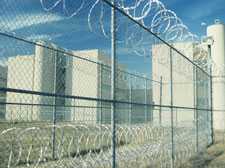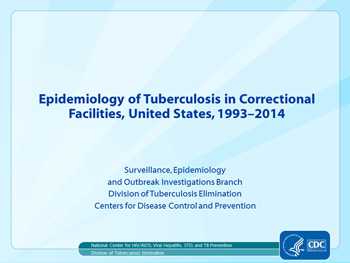TB in Correctional Facilities in the United States
Background
Approximately 4-6% of TB cases reported in the United States occur among people incarcerated at the time of diagnosis. The incarcerated population contains a high proportion of people at greater risk for TB than the overall population.
TB Control in Correctional Facilities

Effective TB prevention and control measures in correctional facilities include:
- Early identification of persons with TB disease through entry and periodic follow-up screening;
- Successful treatment of TB disease and latent TB infection;
- Appropriate use of airborne precautions (e.g., airborne infection isolation, environmental controls, and respiratory protection);
- Comprehensive discharge planning; and
- Thorough and efficient contact investigations when a TB case has been identified.
These measures should be instituted in close collaboration with local or state health department TB-control programs and other key partners. Continuing education of inmates, detainees, and correctional facility staff is necessary to maximize cooperation and participation. To ensure TB prevention and control measures are effective, periodic program evaluation should be conducted.
Data on TB in Correctional Facilities
Surveillance data
Tuberculosis Cases and Percentages by Residence in Correctional Facilities, Age > 15: Reporting Areas, 2014 (Reported Tuberculosis in the United States, 2014).
This chart provides an overview of the number of TB cases reported as diagnosed in correctional settings in the U.S. and a breakdown by state.
Epidemiology of Tuberculosis in Correctional Facilities, United States, 1993-2014 (slide set)
This slide set provides a summary of TB cases in a correctional facility at the time of diagnosis for the years 1993 through 2014.
Resources on TB and Correctional Facilities
- CDC Recommendations
- Prevention and Control of Tuberculosis in Correctional and Detention Facilities; Recommendations from CDC MMWR 2006; 55 (No, RR-09, 1-44)
- Tuberculosis in Correctional Settings: What Corrections Staff Need to Know (Slide Set)
- Prevention and Control of Tuberculosis in Correctional and Detention Facilities (Slide Set)
- CDC Correctional and Public Health Resources by State
- Southeastern National Tuberculosis Center Corrections Toolkit
- National TB Controllers Association (NTCA) CorrectTB Resources
For additional CDC resources on TB, see Patient and General Public Materials and Health Care Providers and TB Program Materials.
Related Links
- American Correctional Association
- Find TB Resources- Education Materials for TB in Corrections
- Federal Bureau of Prisons
- National Commission on Correctional Healthcare
- National Institute of Corrections
- National Institute of Justice
- National TB Controllers Association (Corrections Committee)
- United States Department of Justice
- United States Immigration and Customs Enforcement
- Page last reviewed: September 1, 2012
- Page last updated: November 30, 2015
- Content source:


 ShareCompartir
ShareCompartir

